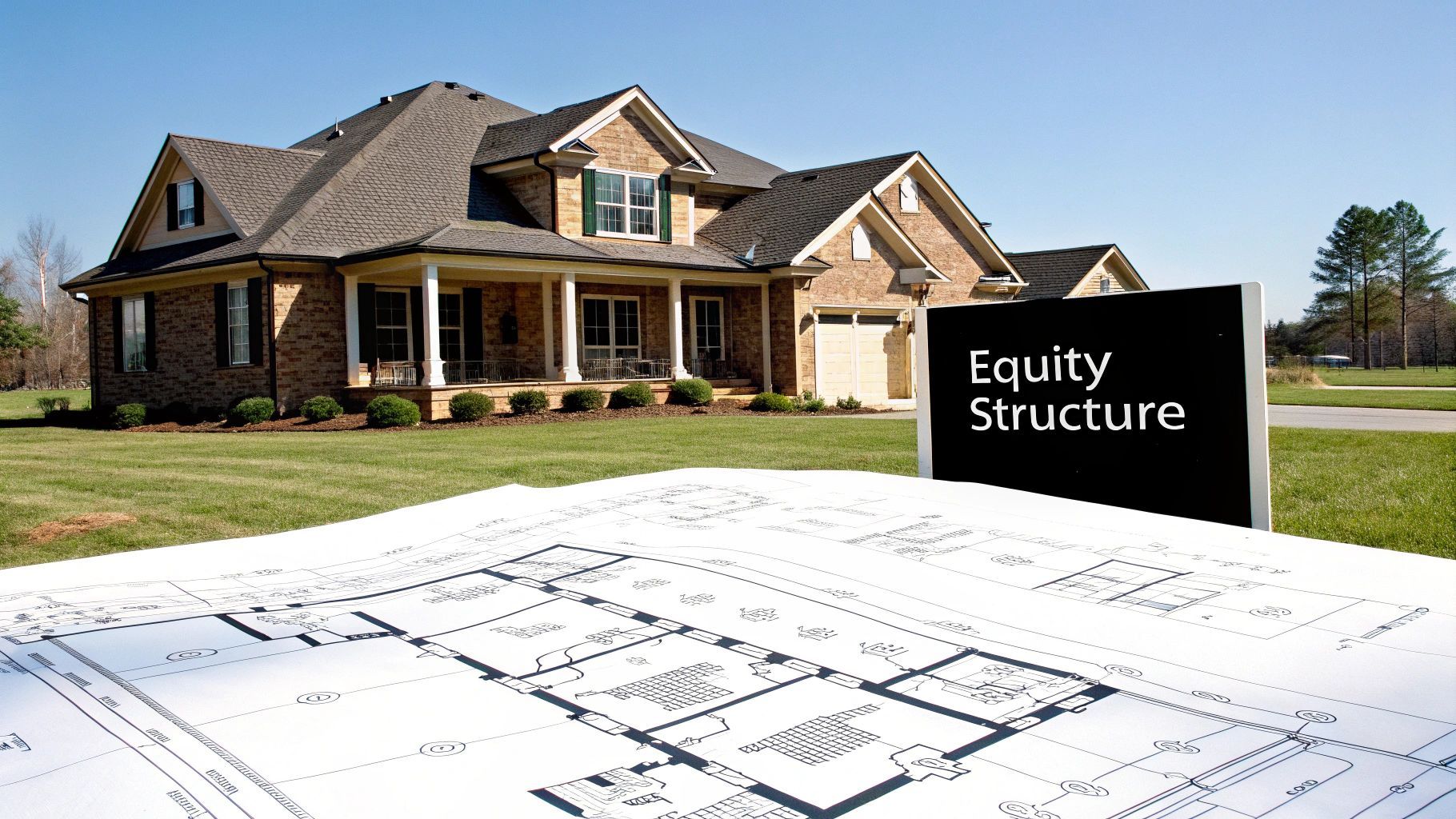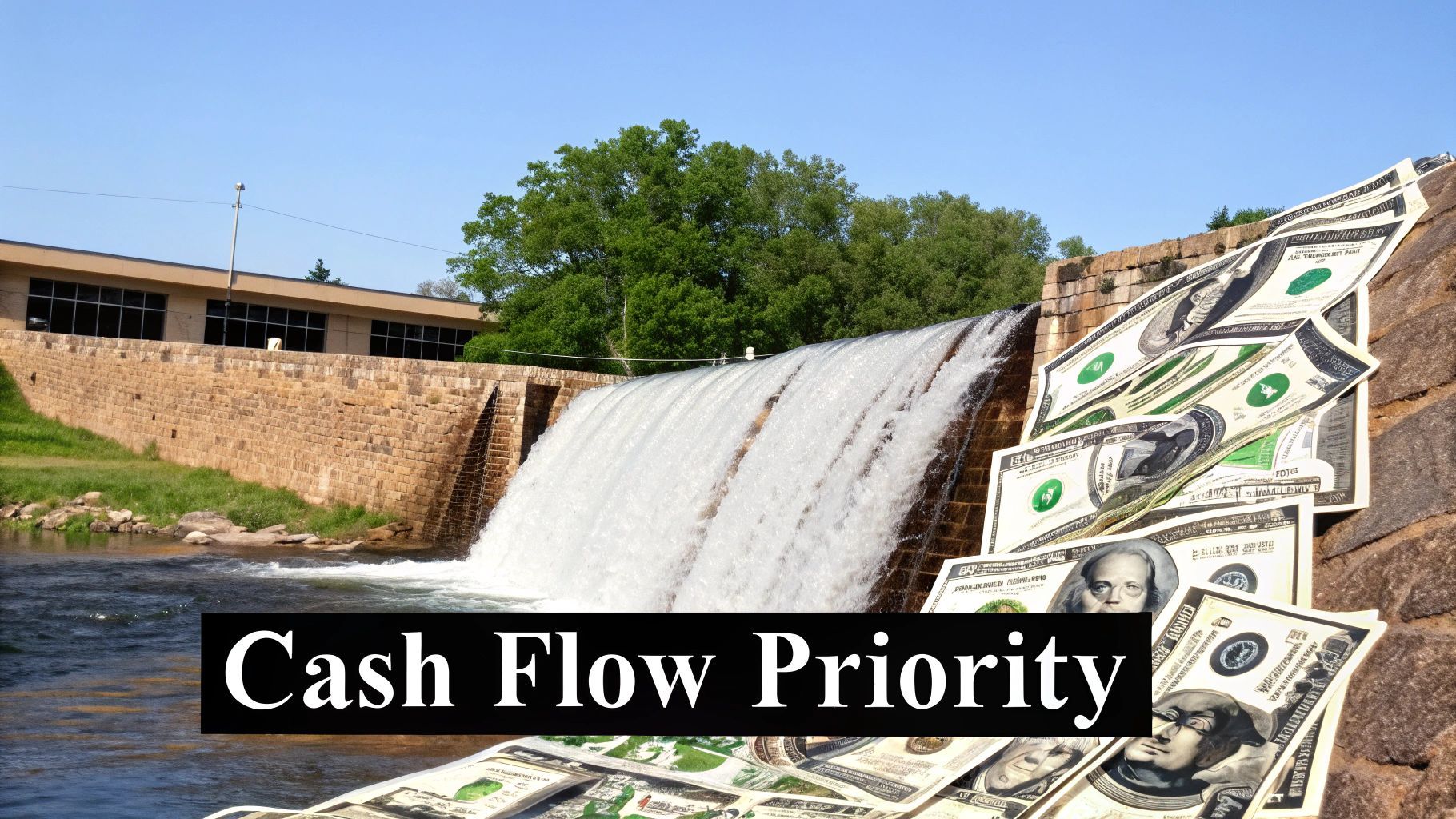Understanding Real Estate Equity Waterfall: A Complete Guide for Modern Investors
Understanding Real Estate Equity Waterfall: A Complete Guide for Modern Investors
Master the complexities of real estate equity waterfall structures for measurable returns. Discover proven frameworks from industry veterans on structuring, calculating, and optimizing waterfalls that drive investment success.
Domingo Valadez
Jan 30, 2025
Blog
The Evolution of Real Estate Equity Waterfalls

Real estate equity waterfalls began as basic profit-sharing agreements between investors and sponsors, with simple fixed percentage splits regardless of performance. While straightforward, these early models had clear limitations - particularly in motivating sponsors to maximize returns for investors.
A major shift occurred in the 1990s as private real estate equity investments gained popularity. During this period, pooled investment funds emerged as investors sought opportunities in falling real estate markets. These funds attracted investors looking to diversify their portfolios and benefit from real estate's income generation and inflation protection. This led to the development of more sophisticated waterfall structures that used performance milestones to align sponsor and investor interests. For more background, see this detailed analysis of waterfall structures.
The Introduction of Hurdles and Preferred Returns
As the market grew more complex, new structures emerged to better serve all parties. The concept of preferred returns gave investors priority access to profits up to a certain percentage before sponsors could participate. This provided a baseline level of security that helped attract more investment capital.
Hurdle rates were another key innovation, creating performance benchmarks that triggered different profit-sharing levels. For example, sponsors might receive 20% of profits up to a 15% return, then 30% above that threshold. This incentivized sponsors to work harder for better returns since their profit share increased with performance.
Modern Waterfall Structures: A Dynamic Approach
Today's real estate equity waterfalls feature multiple tiers with distinct hurdle rates and splits. This allows for precise calibration of risk and reward at different performance levels. A typical structure might include a preferred return tier, followed by several hurdle tiers with increasing sponsor profit shares.
Modern structures also incorporate flexible elements like catch-up provisions. These allow sponsors to earn a larger share of profits after investors hit their preferred return, helping ensure fair compensation for exceptional performance. By carefully balancing investor protection with sponsor incentives, these dynamic structures help real estate ventures attract both capital and talent. The ongoing refinement of waterfall structures reflects the growing sophistication of real estate investment and the need to serve diverse stakeholder interests.
Key Components of Waterfall Structures

Real estate equity waterfall structures are intricate arrangements that determine how profits are shared between investors and sponsors. These structures go beyond basic profit splits to create alignment between all parties involved. Let's explore the key elements that make these structures work effectively.
Preferred Returns and Hurdle Rates
The preferred return forms the foundation of most waterfall structures. This is the baseline return that investors receive before sponsors can participate in any profits. Working alongside this is the hurdle rate - a specific return threshold that must be met before the profit-sharing arrangement shifts.
A typical example would be a 10% preferred return. This means investors get most or all of the cash flow until they've earned a 10% annual return on their investment. After reaching this hurdle, the sponsor starts receiving a larger share of profits. This system encourages sponsors to exceed investor expectations since their own earnings increase with better performance.
Catch-Up Provisions and Tiered Structures
Most waterfalls include catch-up provisions that allow sponsors to receive their share of profits after investors hit their preferred return targets. These provisions often create multiple tiers within the structure.
For example, after investors receive their initial 10% preferred return, a new split might kick in giving the sponsor 35% of profits above that threshold. If returns reach 15%, the sponsor's share could increase to 50% of additional profits. You can learn more about these structures on J.P. Morgan's real estate insights page. This tiered approach rewards sponsors for achieving higher returns while protecting investor interests.
Balancing Complexity and Transparency
While sophisticated waterfall structures can better align interests, keeping them clear and understandable is essential. The investment agreement should spell out each tier, hurdle rate, and profit split in plain language. When all parties fully understand how the waterfall works, it creates trust and promotes collaboration. The best structures find the right balance between detailed incentives and simple, clear terms everyone can follow.
Understanding Promote Structures

When it comes to real estate investments, the equity waterfall determines how profits flow to different partners. At the heart of this structure is the promote - a key mechanism that shapes how returns are shared between parties. Let's explore how promotes work and why they matter for successful real estate partnerships.
Defining the Promote in Real Estate
The promote, also called carried interest, rewards the sponsor (general partner) for strong investment performance. Think of it as a bonus that gives the sponsor a bigger share of profits, but only after investors receive their target returns first. For example, once a project hits an 8% return, the sponsor might get 20% of additional profits while investors receive 80%. This structure means sponsors earn more by making the investment more profitable. You can learn more about the mechanics in this guide to equity waterfalls.
Structuring Promotes for Different Strategies
The promote structure changes based on the investment approach and risk level:
- Value-Add Projects: These deals often have higher promotes since sponsors must actively improve properties to boost returns. The extra work and risk justify a larger share of profits.
- Development Deals: Ground-up construction carries the most uncertainty, so sponsors typically get the biggest potential promote to match the challenge.
- Stabilized Assets: With lower-risk existing properties, promotes tend to be more modest since less heavy lifting is needed.
Promote Structures and Investor Alignment
A well-designed promote balances incentives for both sponsors and investors. The key is setting realistic performance targets tied to market conditions, not pie-in-the-sky numbers. Clear communication about how the promote works builds trust between partners. When structured properly, promotes motivate sponsors to work hard while ensuring investors get their fair share of returns.
Mastering Waterfall Calculations

Real estate equity waterfall calculations can make or break your profit distributions and investor relationships. Getting these calculations right requires attention to detail and a solid understanding of the mechanics. For a deeper dive into the fundamentals, check out this guide on real estate waterfall structures.
Understanding the Calculation Process
The foundation of any waterfall calculation is the Limited Partnership Agreement (LPA), which sets up a tiered structure for distributing returns. Each tier has specific return thresholds and distribution percentages that determine how profits flow to different stakeholders.
Here's how the tiers typically work:
- Preferred Return: Investors get their baseline returns first, usually calculated as an annual percentage
- Catch-Up: Once the preferred return is met, sponsors may receive a larger share to make up for initial lower distributions
- Additional Tiers: Further profit splits kick in at higher return thresholds, giving sponsors more upside for strong performance
Handling Irregular Cash Flows
Most real estate investments don't generate steady monthly income. A property sale might create a large one-time distribution, while other periods may have minimal cash flow. These fluctuations affect how preferred returns accumulate and when different profit tiers are reached.
Good record-keeping becomes essential for tracking distributions accurately over time. Many sponsors use specialized software to automate these calculations and provide clear reporting to investors.
Common Calculation Challenges and Solutions
Mistakes in waterfall calculations often happen when allocating cash flows between preferred and excess returns. For instance, with a $100,000 investment earning a 7% preferred return over five years and generating $10,000 in annual cash flows, calculation errors can lead to $2,252 in misallocated distributions - representing 4.46% of total distributions.
To avoid these issues, managers must fully understand the economic terms in the LPA and match their calculations precisely. This includes properly documenting assumptions and testing calculations against expected scenarios. For more insights, see common issues in waterfall calculations.
Utilizing Technology for Accuracy and Transparency
While spreadsheets work for basic waterfalls, purpose-built real estate investment platforms offer major advantages for complex structures. These tools automatically handle calculations, track distributions, and generate detailed reports. This reduces errors while giving investors clear visibility into their returns. The right technology allows sponsors to focus on deal execution rather than getting bogged down in manual calculations.
Implementing Proven Waterfall Strategies
Building an effective real estate equity waterfall takes more than theory - it requires careful planning and execution that serves both investors and sponsors. Here's how leading firms approach this critical component of real estate investing.
Designing a Robust Waterfall Structure
The best waterfall structures carefully match the investment strategy and risk level of each project. For example, development projects with higher inherent risk often use more aggressive promotes to compensate sponsors who deliver strong returns. A sponsor might receive a larger profit share after reaching key milestones. In contrast, core-plus investments focused on stable, income-producing properties typically employ more balanced structures with moderate hurdle rates and profit splits.
The design must also align with what investors want to achieve. Some prioritize steady cash distributions while others focus more on long-term appreciation. A well-designed waterfall balances these varying investor goals with what sponsors need to drive performance.
Documentation and Transparency: Building Trust
Clear documentation forms the foundation of trust between sponsors and investors. The Limited Partnership Agreement (LPA) plays an essential role by spelling out all waterfall components - from preferred returns to catch-up provisions to profit splits. Any unclear terms can lead to disputes, so precision is key.
Regular updates on performance metrics and distributions help maintain transparency throughout the investment period. This ongoing communication strengthens relationships between sponsors and investors.
Executing the Waterfall: Maintaining Fairness and Flexibility
Proper execution requires careful oversight of cash flows, accurate distribution calculations, and timely payments to all parties. While following the agreed structure is important, some flexibility helps handle unexpected changes.
For instance, a value-add project facing higher renovation costs than planned may need adjustments to maintain fairness for everyone involved. Many leading firms use software platforms like Homebase to automate calculations, manage distributions, and provide clear reporting. This reduces errors while allowing sponsors to focus on maximizing returns.
Success comes from balancing consistent execution with the ability to adapt when needed. Firms that get this right build lasting credibility with their investors.
Future-Proofing Your Waterfall Structure
As real estate markets evolve, successful equity waterfall strategies must adapt to attract and retain investors. Smart sponsors focus on three key areas: understanding changing investor needs, using expanded performance metrics, and adopting tools that improve efficiency.
Adapting to Evolving Investor Preferences
Investors' priorities are shifting beyond just financial returns. Many now seek investments aligned with environmental, social, and governance (ESG) standards. Some waterfall structures now include bonus incentives for meeting sustainability targets or achieving positive community impact metrics. Investors also expect easy access to performance data and clear reporting - making transparency a must-have feature of modern waterfall design.
Incorporating New Performance Metrics
While IRR and equity multiples remain essential measures, forward-thinking sponsors are adding more detailed indicators. Net operating income (NOI) growth and occupancy rates provide deeper insights into property performance. For instance, a sponsor could earn higher profit shares by exceeding specific NOI targets, creating direct incentives for hands-on management. This approach helps align interests by rewarding actual operational achievements.
Leveraging Technology for Efficiency and Transparency
New software tools are making waterfall management simpler and more accurate. Purpose-built platforms handle complex calculations automatically while giving investors real-time access to distribution data and performance metrics. This automation reduces errors and frees sponsors to focus on strategy and dealmaking instead of spreadsheets. The right technology creates trust through transparency while saving significant time.
Evaluating and Implementing New Approaches
Making changes to waterfall structures requires careful planning. Sponsors should:
- Test different scenarios to model potential outcomes
- Ensure changes support overall investment goals
- Document and communicate all modifications clearly
- Balance innovation with proven fundamentals
These steps help create waterfalls that work well for both sponsors and investors over the long term.
Ready to simplify your real estate syndication and waterfall management? Homebase provides an all-in-one platform for fundraising, investor relations, and deal management. Our tools handle the complex calculations while giving you and your investors clear visibility into performance. Visit us today to request a demo and learn how we can help you focus on growing your business.
Share On Linkedin
Share On Twitter
Share On Linkedin
Share On Twitter
DOMINGO VALADEZ is the co-founder at Homebase and a former product strategy manager at Google.
What To Read Next
Rolling Up Car Washes: How Adiola Oladimiji is Using Private Equity to Build a Cash Flow Empire
Podcast
The forty-eighth episode of Groundbreakers Podcast by Homebase! Listen in for an amazing interview with Adeola Oladimeji, General Partner at Ascendi Capital.
Top Real Estate Crowdfunding Platforms: A Complete Guide To Maximizing Property Investment Success
Blog
Discover the top real estate crowdfunding platforms for transforming your property investment journey. Learn proven strategies for evaluating platforms, building a resilient portfolio, and generating exceptional returns while minimizing risks.
Sign up for the newsletter
If you want relevant updates from our team at Homebase, sign up! Your email is never shared.
Sign up for the newsletter
If you want relevant updates from our team at Homebase, sign up! Your email is never shared.